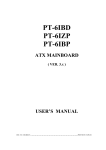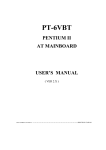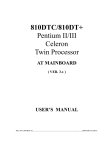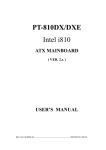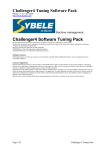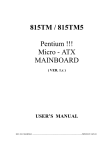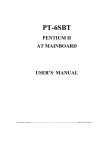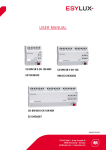Download 440bx mainboard
Transcript
PT-6IBP ATX PENTIUM II MAINBOARD ( VER. 2.x ) USER’S MANUAL DOC. NO. UM-IBP-E2 ...................................................................PRINTED IN TAIWAN 440BX TABLE OF CONTENTS MAINBOARD TABLE OF CONTENTS Chapter & Section Page 1. INTRODUCTION ..................................................................................1-1 1.1 1.2 1.3 OVERVIEW .................................................................................................1-1 MAINBOARD LAYOUT ...........................................................................1-2 SPECIFICATIONS......................................................................................1-3 2. INSTALLATION ...................................................................................2-1 2.1 2.2 2.3 UNPACKING ...............................................................................................2-1 AMAZING WAYS TO POWER ON THE PC SYSTEM........................2-1 POWER OFF THE PC SYSTEM ..............................................................2-4 3. HARDWARE SETUP...........................................................................3-1 3.1 3.2 3.3 3.4 INSTALLATION OF CPU .........................................................................3-1 INSTALLING THE DRAM MODULES ...............................................3-2 CONNECTORS............................................................................................3-4 JUMPERS.....................................................................................................3-15 4. AWARD BIOS SETUP ........................................................................4-1 4.1 4.2 4.3 4.4 4.5 4.6 4.7 4.8 4.9 4.10 4.11 4.12 4.13 4.14 GETTING STARTED ................................................................................4-1 MAIN MENU ..............................................................................................4-2 CONTROL KEYS.......................................................................................4-2 STANDARD CMOS SETUP.....................................................................4-3 BIOS FEATURES SETUP........................................................................4-4 CHIPSET FEATURES SETUP................................................................4-6 POWER MANAGEMENT SETUP .........................................................4-9 INTEGRATED PERIPHERALS ..............................................................4-13 PNP/PCI CONFIGURATION...................................................................4-15 LOAD SETUP DEFAULTS......................................................................4-18 SUPERVISOR PASSWORD / USER PASSWORD.............................4-19 IDE HDD AUTO DETECTION ..............................................................4-20 SAVE & EXIT SETUP .............................................................................4-21 EXIT WITHOUT SAVING ......................................................................4-22 i 440BX MAINBOARD SOMETHING IMPORTANT ! ¶ TRADEMARKS All trademarks used in this manual are the property of their respective owners. ¶ LOAD SETUP DEFAULTS “LOAD SETUP DEFAULTS” is the function which will have the BIOS default settings loaded into the CMOS memory, these default settings are the best-case values which will optimize system performance and increase system stability This function will be necessitated when you receive this mainboard, or when the system CMOS data is corrupted. Please refer to the Section 4.8 for the procedures. ¶ DISCHARAGE CMOS DATA Whenever you want to discharge the CMOS data or open the system chassis, Make sure to disconnect the AC power first because there is always the 5V standby voltage connected to the ATX form-factor mainboard. Without disconnecting the AC power connector from the PC system, the mainboard can be damaged by any improper action . ¶ WAKE ON LAN In order to support the Wake On LAN feature, the system requires a special SPS (Switching Power Supply), Such power supply must be able to provide at least 700 mA of driving capability on the “5V standby” voltage. Please refer to the Section 3.3 for pin assignment. ¶ WARNING ! The "Static Electricity" may cause damage to the components on the mainboard, In order to avoid the damage to the mainboard accidentally, please discharge all static electricity from your body before touching this mainboard. ¶ NOTICE Information presented in this manual has been carefully checked for reliability; however, no responsibility is assumed for inaccuracies. The information contained in this manual is subject to change without notice. ii 440BX INTRODUCTION MAINBOARD 1. INTRODUCTION 1.1 OVERVIEW This Mainboard is a high performance personal computer mainboard designed for Pentium™ II and Celeron™ processors. It is a Slot1, ATX form-factor mainboard with A.G.P. (Accelerated Graphics Port) and PCI Local Bus on board, Designed based on the Intel® 82440BX AGPset™ system chipset and Winbond® I/O chipset. It is designed for 233MHz, 266MHz, 300 MHz, 333MHz , 350MHz, 400MHz and 450MHz high performance Pentium™ II and Celeron™ (S.E.C. Cartridge) processor for high-end and true GREEN-PC computer systems This mainboard is designed for both Intel® 82440BX and 82440ZX AGPset™ system chipset. When different chipset is installed on the board, the feature of the mainboard will be different as following: PCI SLOTS DIMM SOCKETS ECC SUPPORTING BX Mainboard ZX Mainboard 5 3 YES 4 2 NO This mainboard has built-in two channel “PIO” and “Ultra DMA/33 Bus Master” mode PCI IDE ports, one Floppy Disk control port, two high speed Serial ports (UARTs) and one multi-mode Parallel port and supports PS/2™ mouse, IR and USB ports. It is designed to support the high performance Pentium™ II and Celeron™ processors for the high-end and true GREEN-PC computer systems. Pentium™ II and Celeron™ are the 64-bit processors with RISC technology, which offers several key features such as built-in 512K/128K L2 cache, 12-stage super-pipeline architecture, out of order execution .... etc. In order to optimize of its capabilities and performances, the 32-bit Operating System (such as Windows® NT and OS/2™) and 32-bit applications are recommended. The Accelerated Graphics Port (A.G.P.) on the mainboard is designed for AGP 3D video display card. Unlike PCI-based display cards, the AGP technology provides lightning data throughput to fully facilitate the 3-Dimensional and multimedia graphics display. The data transfer rate on AGP can be up to 133Mhz and which is much faster than the traditional 33MHz PCI VGA card. 1-1 440BX CN4 CN 1 CN11 FDC CN9 IDE 2 CN10 IDE 1 SLOT1 CPU FAN CN3, CN6, CN7 CN2 AGP SLOT JP100 PCI SLOT SPKR BAT1 PCI SLOT PCI SLOT CN14 PCI SLOT BIOS PCI SLOT ISA SLOT ISA SLOT 1-2 KBLOCK CN 1 MAINBOARD LAYOUT USB USB 2 1 1.2 INTRODUCTION MAINBOARD 440BX 1.3 INTRODUCTION MAINBOARD SPECIFICATIONS ¥ CPU Intel® Pentium™ II and Celeron™ processor 233 MHz, 266 MHz, 300 MHz, 333MHz. 350MHz, 400MHz, 450MHz and up to 500MHz. ¥ CPU VCC Switching Voltage Regulators on board, supports +1.80V DC through +3.5V DC CPU Core Voltage. Note : The CPU Core Voltage will be Detected and adjusted automatically by the VID-pin on the CPU, so there is no jumper setting required.. ¥ WORD SIZE Data Path : Address Path 8-bit, 16-bit, 32-bit, 64-bit : 32-bit ¥ PC SYSTEM CHIPSET Intel® 82440BX AGPset™ (82443BX, 82371EB) ¥ SUPER I/O CHIPSET Winbond® W83977TF-AW ¥ FRONT SIDE BUS FREQUENCY 66 MHz and 100MHz selectable. ¥ MEMORY DRAM : Three 168-pin DIMM sockets are designed onboard which support 8, 16, 32,64 or 128MB 3.3V SDRAM DIMM module. Maximum memory size can be up to 384 MB with Parity / ECC (Error Checking and Correcting) supported. CACHE: 512KB pipelined burst SRAM built-in Pentium™ II processor. 0KB or 128KB SRAM in Celeron™ processor. ¥ BIOS AWARD System BIOS. 128KB x 8 Flash ROM (Supports Plug & Play, ACPI, DMI and Green functions). ¥ EXPANSION SLOTS AGP Slots : 32-bit x 1 PCI Slots : 32-bit x 5 ISA Slots : 16-bit x 2 (Supports 1x or 2x AGP graphics cards) (All Master/Slave, PCI 2.1 Compliant) (One of the slot is PCI/ISA shared) 1-3 440BX INTRODUCTION MAINBOARD ¥ WOL PORTS One WOL connector supports Wake-On-LAN (WOL up-designed) ¥ SB-LINK PORTS One SB-LINK feature connector to support PCI sound cards. (such as Creative™ Labs EMU8008 sound chip) ¥ USB PORTS Two Universal Serial Bus (USB) ports. ¥ IDE PORTS Two channels of Ultra DMA/33 Bus Master IDE ports, which will support up to 4 IDE devices like IDE hard disk, ATAPI CD-ROM and LS-120/ZIP-100 devices. The IDE ports can be programmed to support PIO Mode 4, DMA mode 2 and Ultra DMA/33. ¥ SUPER I/O PORTS 1. Two high speed NS16C550 compatible serial ports (UARTs). 2. One parallel port, supports SPP/EPP/ECP mode. 3. One Floppy Disk Control port. ¥ IR PORT One HPSIR and ASKIR compatible IR transmission connector (5-pin). One Consumer IR transmission connector (4-pin, optional). ¥ MOUSE AND KEYBOARD One PS/2™ mouse connector, One PS/2™ keyboard connector. ¥ HARDWARE MONITORING (optional) Winbond W83781D is designed on the board to monitor hardware healthy status like system voltage, system temperature, and cooling fans. When the CPU is over heated, the system BIOS will tell the system board to give a series of beeping alarm and then slow down the CPU speed (throttling speed) so that you can take proper action to prevent your system from damage. When you hear the beeping alarm, be sure to turn the power off and check on the cooling fans (especially the CPU cooling fan ) to see whether it is working properly or not. If you don’t know how to handle it, send the PC system to your dealer for technical support. 1-4 440BX INTRODUCTION MAINBOARD This mainboard includes the hardware monitoring program and you can use it to monitor the system healthy status. When you find there is the Winbond W83781D installed on the board, you can run the hardware monitoring program which comes in the CD disc and then it will monitor the system healthy status all the time. ¥ ACPI Advanced Configuration and Power Interface (ACPI) function is strongly recommended by PC’98 because it will let you have many additional features and that will make your PC system becomes very friendly and convenient. Followings are the ACPI features designed on the board: 1. On Now: power on the system by panel-switch, Keyboard, PS/2™ Mouse, Modem ring-in, RTC alarm or LAN signal. (keyboard and PS/2 mouse OnNow function can be enabled or disabled by JP11) 2. Power off (Soft-off) by OS or Panel-switch. 3. CPU cooling fan auto-off during Suspend state. 4. Resuming of PC system. (such as Modem ring-in, RTC alarm, .... etc.) 5. Supports Full-On/Doze/Standby/Suspend operating modes. ¥ DIMENSION 1. Width & Length 2. Height 3. PCB Thickness 4. Weight : 305 mm x 190 mm. : 2 1/2 inches with CPU Retention Mechanism. : 4 layers, 0.05 inches normal. : 18 ounces. ENVIRONMENT LIMIT 1. Operating Temperature : 10 to 40 . (50 to 104 ) 2. Required Airflow : 50 linear feet per minute across CPU. 3. Storage Temperature : - 40 to 70 . (- 40 to 158 ) 4. Humidity : 0 to 90% non-condensing. 5. Altitude : 0 to 10,000 feet. 1-5 440BX INSTALLATION MAINBOARD 2. INSTALLATION 2.1 UNPACKING The mainboard contains the following components. Please inspect the following contents and confirm that everything is there in the package. If anything is missing or damaged, call your supplier for instructions before proceeding. l l l l l This mainboard. One USER‘S MANUAL. One Cable set for IDE and Floppy devices. One Pentium™ II Processor Retention Mechanism (RM). One CD diskette for device driver and utility programs. This mainboard contains electrostatic sensitive components and it can be easily damaged by static electricity. So please leave it sealed in the original packing until when installing. A grounded anti-static mat is recommended when unpacking and installation. Please also attached an anti static wristband to your wrist and have it grounded to the same point as the anti-static mat. After the opening of the mainboard carton, please observe the mainboard carefully to make sure there is no shipping and handling damage before you can start to install the PC system. Having finished all the procedures above, you are now ready to install the mainboard to the chassis. Please make sure that the chassis is the ATX type so that the mounting hole will match with this mainboard. 2.2 AMAZING WAYS TO POWER ON THE PC SYSTEM When the mainboard has been installed successfully, there are several ways to power on the system. Please read the following description for all the details. 2-1 440BX INSTALLATION MAINBOARD POWER BUTTON The power button can be programmed by COMS setup program and it has different features. Please refer to page 3-13 and page 3-14 for detail function description. Note: This power button can not be used to power-on the PC system if the ”Password“ is selected to power on your system. (please refer to Section 4.8 for the “INTEGRATED PERIPHERALS“ in the CMOS setup.) However, you can always use the power button to turn off the power. ¨ KEYBOARD (PASSWORD OR HOT KEY) This mainboard allows you to enter your personal password or a combination of hot key and you can use it to power on your PC system. When the jumper setting on JP11 is “Enabled”, this mainboard will keeps scanning the keyboard status when the system power is off, waiting for the correct password or hot key input to turn on the system power (the stand-by 5V is still working and the power LED on the keyboard is still active). Without the correct password or hot key, no one else can turn on the PC system ( neither by the power button ). So the PC system is secured for you. ( Please refer to Section 4.8 for the BIOS setup. ) When the “Password” and “Hot KEY” is selected, you will have to reboot the PC system to activate the setting, when you see the POST (Power On Self Test) is completed, the setting is changed and stored in the CMOS memory. Having finished the procedure, you may turn the power off and then you can use the keyboard to power-on the PC system afterward. In case that you forget the “Password” or “Hot Key”, disconnect the AC power for 30-60 seconds then re-connect the AC power to the PC system, the power button will be activated again and you can use the power button to turn on the system. Input your personal password again in the BIOS setup program, and then you may use the new password to power-on the PC system afterward. ¨ PS/2™ MOUSE (Left or right mouse button) When you are tired of pressing on the power button or keying in the password to turn on the PC system, there is another extremely convenient way for you. When you have a PS/2™ mouse connected to the system, you may use the jumper setting on JP11 and change the setup in the BIOS so that you can use the mouse click to turn on the PC system power. Please refer to section 4.8 for the BIOS setting 2-2 440BX INSTALLATION MAINBOARD To use the mouse key to turn on the PC system power, the mouse click must be done quickly and continually. Basically, 2-5 quick clicks on the mouse key ( left key or right key ) will turn the power immediately. In order to activate the mouse key feature, you will have to reboot the PC system after the BIOS setting and wait until the POST (Power On Self Test) is completed. Having finished the procedure, you may use the mouse key to power-on the PC system afterward.. Note: This feature is not available on the COM port mouse(serial mouse). ¨ RTC ALARM PC system can be waked up by the RTC setting in the CMOS. You can set the alarming date and time in the RTC memory, When RTC alarms, the PC system will be triggered and wakes up automatically. Enable the “Resume by Alarm” selection in the BIOS setup utility, and then input the accurate date and time in following fields. (the “Resume by Alarm” is located in the “POWER MANAGEMENT SETUP”, please refer to Section 4.7), Having stored the RTC alarm setting, the PC system will be turned on automatically according to the date and time which is recorded in the CMOS memory. Same as the above, you have to reboot the PC system and wait for the POST (Power On Self Test) is completed to enable the RTC alarm. ¨ MODEM RING-IN Everyone knows that a PC system can be used as a fax machine to send or receive fax messages. But most people still use fax machine to receive their messages because it is not practical to have the system powered on all day long waiting for the incoming messages. Now the problem can be solved by using this mainboard. This mainboard can be triggered by a modem ring-in signal. When you have a external modem installed, you can leave the PC system power off. Whenever there is the incoming message, the PC system will be triggered by the ring-in signal and wake up automatically to receive the message for you. From now on, you can tell your PC system to receive the fax message for you. In order to use the ring-in signal to wake up your PC system, you will have to use the EXTERNAL MODEM and have it connected to one of the SERIAL PORTS 2-3 440BX INSTALLATION MAINBOARD ( COMA or COM B ). When the system power is off, this mainboard will continue to detect the serial port status. When it detects the ring-in signal from the serial port, the system power will be turned on and start to receive the incoming messages automatically. ( you need to have the software like Award Zero-Volt Data-Suspend Utility so that you can use the fax utility to receive the incoming fax message ). To enable the Modem Ring-In feature, you have to run the BIOS setup utility and enable the “Resume by Ring or LAN” option (it is located in the “POWER MANAGEMENT SETUP”, please refer to Section 4.7 for the settings). Having completed the BIOS setup, you have to reboot the PC system so that BIOS can verify the setting. (the “DMI pool data” will be verified by the BIOS when loading the operating system). Simply speaking, shut down the PC system and then re-start the system. The modem ring-in feature will be enabled when the operation system has been loaded. Note: This function is not available when using the internal MODEM card. ¨ WAKE ON LAN ( WOL ) There is a WOL connector CN12 (see page 3-10) on the mainboard which is designed to connect to the signal from a LAN card which supports the Wake On LAN feature. When such LAN card is installed, you may turn on the PC system from your remote server and monitor the PC status. To enable this feature, you will have to use the BIOS setup utility to enable the “Resume by Ring or LAN” (it is located at “POWER MANAGEMENT SETUP”, please refer to Section 4.7 for the settings). Having completed the BIOS setup, you have to reboot the PC system so that BIOS can verify the setting. ( the “DMI pool data” will be verified by the BIOS when loading the operating system). Simply speaking, reboot the PC system, the Wake On LAN feature will be enabled when the operation system has been loaded Note: This function will be disabled if you turn off the power before the system can verify the DMI pool data. 2.3 POWER OFF THE PC SYSTEM There are two ways to power off the system. They are “Shut Down by Power Button” and “ Shut Down by OS”. (such as Windows® 95 and Windows® 98, you can choose the Shut Down from the file menu and the system will be powered off immediately ). 2-4 440BX HARDWARE SETUP MAINBOARD 3. HARDWARE SETUP Before you can start to install this mainboard, some hardware settings is required to make sure it will work perfectly with the component which you are going to install in your PC system. To configure the mainboard is a simple task, only a few jumpers, connectors, cables and sockets needs to be selected and configured. (For the locations of each component please refer to page 1.2 “ mainboard layout” 3.1 INSTALLATION OF CPU When you have installed the Pentium™ II or Celeron™ processor onto the mainboard, it will detect the CPU type and decide the CPU voltage automatically. So you don’t have to make any jumper setting to select the CPU voltage. All you have to do is use JP5, JP6 and JP7 to select the CPU clock ratio. The socket where we are going to plug in the CPU is the slot type connector ( J1 ). This slot is designed for Pentium ™ II or Celeron™ processors and we call such new CPU socket – the SLOT 1. Basically, Slot 1 is a new architecture and it is totally different to the traditional Pentium CPU socket (Socket 7). Because the Slot 1 is a revolutionary new architecture and the installation of Pentium™ II processor will need some additional skill. There are two types of Pentium ™ II CPU - the boxed Pentium™ II processor and OEM Pentium™ II processor. These two different packages are different and they have different accessories. So when installing different type of CPU, the installation procedure will be different. The boxed Pentium™ II processor is for retail purpose and it can be purchased from the retail store. As for the OEM Pentium™ II processor, it is for OEM customers like system integrators to build the PC systems. Sometimes, users will find the OEM Pentium™ II processor sold in the retail store. When you are purchasing the Pentium™ II or Celeron™ processor, please check with the CPU dealer and find the appropriate information to install the processor. Basically, the core logic of boxed Pentium™ II processor and OEM Pentium™ II 3-1 440BX HARDWARE SETUP MAINBOARD processor are identical, The major difference between these two processors is the boxed CPU has head sink, cooling fan and heat sink supporter, while the OEM Pentium™ II CPU doesn’t. As for the Celeron™ processor, it will need the different mechanism to hold the CPU, please check with your CPU supplier for the require materials. 3.2 INSTALLING THE DRAM MODULES The 440BX chipset integrates a main memory controller that supports a 64-bit DRAM interface. The DRAM controller supports the following features: 1. 2. 3. 4. DRAM type: Synchronous (SDRAM) DRAM. Memory size: 8MB to 512MB. Memory modules supported: Single and double density 3.3V DIMMs. DRAM speed: 60ns for asynchronous and equivalent SDRAM 100/66 MHz parameters for synchronous memory. This mainboard supports three 168-pin DIMM sockets (DIMM1, DIMM2, and DIMM3), each DIMM can be single-bank or double-bank, 8MB up to 512 MB of local memory can be populated on the board. Only the Synchronous (SDRAM) memory is recommended because it will give a better performance. (Both Symmetrical and Asymmetrical DRAM addressing are supported.),. This mainboard provides a DIMM plug-and-play support via Serial Presence Detect (SPD) mechanism supported via the SMBus interface. In order to give the best performance to the PC system, the DIMM module with SPD is strongly recommended especially when installing the 100MHz processor to the board. The SDRAM module with SPD is designed to increase the system performance and make system more stable and compatible at the same time. When the system BIOS detects the SPD DIMM module populated on the mainboard, the system BIOS will retrieve the information (such as DRAM type, size, access timing ... etc.) which is stored in the DIMM module. The system BIOS will then use such information to determine what operating parameters will be used for individual DIMM module automatically and gives the best performance and reliability to your PC system. 3-2 440BX HARDWARE SETUP MAINBOARD If the system BIOS can not detect the SPD on the DIMM module. the system BIOS will use the default parameters which is saved in the BIOS for the memory subsystem. Such parameter will work with most DRAM modules, but it will reduce the system performance because it is not optimized. According to what Intel suggested, the system board shall stop and not to continue when no SPD module can not be detected. However, this mainboard is downgrade compatible with the 66HMz PentiumTM II processors. In order to make sure that the system board will work normally with 66MHz PentiumTM II processors, the system BIOS will continue to load the operation system when it can not detect the SPD RAM module. Nevertheless, SRAM module with SPD feature is still strongly recommended when you are using the 100MHz Pentium IITM processor. BIOS CN14 SPKR KBLOCK DIMM 1 ( BANK0 + BANK1 ) DIMM 2 ( BANK2 + BANK3 ) DIMM 3 ( BANK4 + BANK5 ) Picture of DRAM subsystem In order to increase of the system performance, two suggestions are recommended when you are installing the DIMM modules : 1. Always use the SDRAM module with SPD so that the PC system will have the best performance (PC100 DIMM module). 2. Always install DIMM module starting from DIMM 1 socket first, and then DIMM 2 and DIMM 3. In the DRAM subsystem, the ECC feature can be used in the DRAM sub-system and make sure there is no mistake on the data transmission (this feature can be selected in the BIOS CMOS setup, please refer to Section 4.6 for the BIOS setting, the default status is Non-ECC selected.) Before you enable the ECC checking feature, please make sure that all DIMM modules have the true parity bit. 3-3 440BX 3.3 HARDWARE SETUP MAINBOARD CONNECTORS The connectors on the mainboard are either the pin header type or D-type connectors, they are used to connect the accessories or peripheral devices (such as power, mouse, printer,...etc.). Following is the connectors with its description and pin assignment which is designed on the mainboard. (A) BAT1: Battery Socket (Use the 3 Volts Lithium battery : CR2032) Pin# + BIOS BAT1: Battery Socket Pin name Pin# Pin name Battery Positive CN14 - Ground SPKR KBLOCK (B) CN1: PS/2 Mouse and Keyboard Connector PS/2 Mouse Connector PS/2 Keyboard Connector BIOS CN14 SPKR KBLOCK 3-4 440BX HARDWARE SETUP MAINBOARD Pin assignment of PS/2 mouse connector: Pin # Signal name Pin # Signal name 1 Mouse Data 3 Ground 2 No Connection 4 + 5V DC Pin # 5 6 Signal name Mouse Clock No Connection Pin assignment of keyboard connector Pin # Signal name Pin # Signal name 1 Keyboard Data 3 Ground 2 No Connection 4 + 5V DC Pin # 5 6 Signal name Keyboard Clock No Connection (C) CN2: USB Port (Universal Serial Bus) Connector USB 1 USB 2 BIOS CN14 SPKR KBLOCK Pin assignment of USB connector: USB 1 1 5 2 3 Pin1: Pin2: Pin3: Pin4: Pin5: Pin6: USB 2 4 1 6 5 2 3 4 6 3-5 +5VDC DATADATA+ Ground Ground Ground 440BX MAINBOARD (D) CN3 & CN7 : HARDWARE SETUP COM A & COM B connector COM A BIOS CN14 COM B SPKR KBLOCK Ping assignment of serial port connector: Signal name Pin # Signal name 1 6 Pin # 1 DCD (Data Carrier Detect) 6 DSR (Data Set Ready) 2 RD (Received Data) 7 RTS (Request To Send) 3 TD (Transmit Data) 8 CTS (Clear To Send) 4 DTR (Data Terminal Ready) 9 RI (Ring Indicator) 5 Ground 5 9 I/O address 3F8H/2F8H/3E8H/2E8H, IRQ3/IRQ4, selected by CMOS setup. (E) CN4: ATX Power Connector BIOS CN14 SPKR KBLOCK ATX Power connector 3-6 440BX HARDWARE SETUP MAINBOARD Pin assignment of ATX power connector 11 1 Pin # 11 12 13 14 15 16 17 18 19 20 Signal name + 3.3V DC - 12V DC Ground PS-ON Ground Ground Ground - 5V DC + 5V DC + 5V DC Pin # 1 2 3 4 5 6 7 8 9 10 Signal name + 3.3V DC + 3.3V DC Ground + 5V DC Ground + 5V DC Ground PW-OK + 5V SB + 12V DC 20 10 (F) CN6: Parallel Port Connector (Supports SPP/EPP/ECP modes, IRQ7 or IRQ5 is selectable, ECP mode will use either DMA channel 3 or channel 1 which can be selected by the CMOS setup probram) Parallel Port BIOS CN14 SPKR KBLOCK 3-7 440BX HARDWARE SETUP MAINBOARD Pin assignment of parallel port: 1 14 Pin # Signal name 1 STROBE 2 Data Bit 0 3 Data Bit 1 4 Data Bit 2 5 Data Bit 3 6 Data Bit 4 7 Data Bit 5 8 Data Bit 6 9 Data Bit 7 10 ACK 11 BUSY 12 PE 13 SLCT 13 25 Pin # 14 15 16 17 18 19 20 21 22 23 24 25 Signal name AUTO FEED ERROR INIT SLCT IN Ground Ground Ground Ground Ground Ground Ground Ground (G) CN8: CPU Cooling Fan Power Connector GND +12V Fan Sense Signal CN8 1 BIOS CN14 2 3 SPKR KBLOCK 3-8 440BX HARDWARE SETUP MAINBOARD (H) CN9, CN10: IDE Connectors Primary IDE Port: 1F0H, IRQ 14 Secondary IDE Port: 170H, IRQ 15 BIOS CN14 SPKR KBLOCK CN9: IDE 2 CN10: IDE 1 (I) CN11: Floppy Disk Control Port Connector (Using IRQ6, DMA channel 2) BIOS CN14 SPKR KBLOCK CN11: FDC Connector 3-9 440BX HARDWARE SETUP MAINBOARD (J) CN12: WOL (Wake On LAN) Connector In order to use the WOL LAN card to trigger the power of the PC system, the switching power supply must be able to provide at least 700mA current driving ability on the “5V standby” voltage. CN 12 WOL BIOS CN14 1 2 3 SPKR KBLOCK Pin assignment of WOL Connector 1 2 3 Pin # Signal name Pin # Signal name 1 5V standby 2 Ground Pin # Signal name 3 WOL Signal (K) CN13: SB-LINK Connector (For PCI bus sound cards. such as Creative™ Labs EMU8008 sound chip) 1 CN 13 3 SB-LINK 5 BIOS CN14 SPKR KBLOCK 3-10 2 4 6 440BX HARDWARE SETUP MAINBOARD Pin assignment of SB-LINK Connector: 1 2 Pin # Signal name 1 GNT# 3 Key 5 Ground 5 6 Pin # 2 4 6 Signal name Ground REQ# SERIRQ (L) CN14: Chassis Fan Power Connector (optional) ( this connector is available only when Winbond W83781D is installed on board ) BIOS CN14 SPKR KBLOCK 1 Ground 2 +12V DC 3 Fan Sense Signal CN 14 Chassis Fan Power Connector (M) CN15: IR / FIR (Infrared Rays) Connector Consumer IR Connector ( Consumer IR connector is active only when W83977CTF-AW I/O Chip is installed on position U11 ) BIOS CN14 SPKR KBLOCK IR/FIR (INFRARED RAYS) CONNECTOR CONSUMER IR CONNECTOR 1B ( +5VDC ) ( +5VDC ) 1A ( NO CONNECTION ) 2A 2B ( IR TRANSMIT ) ( IR RECEIVE ) 3A ( GROUND ) 4A ( IR TRANSMIT ) 5A 3B ( CONSUMER IR RECEIVE ) 4B ( GROUND ) 3-11 440BX HARDWARE SETUP MAINBOARD (N) Push buttons and LED connectors A series of connectors are designed on the board to connect the push buttons and LED indicators. Followings are the details: BIOS CN14 SPKR KBLOCK PW SL HL RS RS: Reset Button connector HL: HDD LED connector SL: Sleep LED connector PW: Power On / Off Suspend switch PUSH BUTTONS AND LED CONNECTORS 1. RS Reset Button Connector Pin1&2 Function Pin # Signal name 1 Reset Control Open No action 2 Ground Short System Reset 2. HL IDE HDD LED Connector Pin # Signal name 1 + 5V DC Pull-up 2 HDD Active Signal 3. SL Sleep LED Connector This LED will be lightened when the AC power is connected and the system is power off, darkened when the AC power is disconnected or the system is powered on. Pin # Signal name 1 Signal Pin 2 Ground 4. PW Power On / Off and External Suspend Switch Connector According to the setup in CMOS, the PW connector has two functions. It can be the Power Switch or Suspend Switch of your PC system. (please refer to Section- 4.7 and section 4.8 for BIOS setup) 3-12 440BX HARDWARE SETUP MAINBOARD If the setup in CMOS is “Delay 4 Sec.”, the function of “PW” will be: A. When system is power off : Press this switch, the system will power on. (when “password” is selected in the CMOS setup program, you will be unable to use the PW button to turn on the power of the PC system, please see Section 2.2 and Section 4.8 for more details. ) B. When system power is on : a. The system is in Full-ON mode : a-1. Click on this switch ( less than 4 seconds ), the system will be turned into Suspend mode. (turn into the GREEN mode) a-2. Press and hold this switch for more than 4 seconds, the system will be powered off. b. When the system is in Suspend mode : b-1. Click on this switch ( less than 4 seconds ), the system will return to Full-ON mode. b-2. Press and hold this switch more than 4 seconds, the system will be powered off. The setup in CMOS is “Instant-off”: A. When system power is off : Click on this switch, the system will be powered on. (when “password” is selected in the CMOS setup program, you will be unable to use the PW button to power on the PC system, please see Section 2.2 and Section 4.8 for more details. ) B. When system power is on : Click on this switch, the system will be powered off instantly. 3-13 440BX HARDWARE SETUP MAINBOARD (O) Speaker and Key Lock connector: BIOS CN14 SPKR KBLOCK 1 2 3 4 5 1 2 3 4 5 SPKR PWR-LED & KBLOCK SPKR & KBLOCK CONNECTORS (X) SPKR: Speaker connector 1 Pin # Signal name 1 + 5V DC 2 No Connection 3 No Connection 4 Speaker Data Signal 5 No Connection 5 (Y) PWR-LED & KBLOCK: Front Panel Power LED and Key-Lock Connector 1 Pin # Signal name 1 Pullup (+ 5V DC for Power LED) 2 No Connection 3 Ground 4 Keyboard Lock 5 Ground 5 3-14 440BX HARDWARE SETUP MAINBOARD 3.4 JUMPERS This section will discuss the jumper setting on the mainboard. In order to let you have better idea of the jumper setting, please see below for the explanation of jumper settings before you start this section. open 1 , short , 2-3 1 1 1-2 1 1 The jumpers in the following sections which labeled with “optional” means they are the optional choice and the related components are normally not populated on the mainboard. In order to make the mainboard works properly in your PC system, please make sure all jumper settings are at correct before installing this mainboard. A jumper is a set of two, three or more jumper pins which allows users to make different system configuration by putting the plastic connector plug (mini-jumper) on it. The jumper setting is necessary when installing different devices onto the mainboard. (A) JP1-JP3: USB Port 2 Function Selection ( optional ) JP3 JP2 JP1 JP3 JP2 JP1 JP3 JP2 JP1 1 1 1 2 2 2 3 3 3 Pin2 & Pin3 Short 1 1 1 2 2 2 1 1 1 2 2 2 3 3 3 3 3 3 Pin1& Pin2 Short BIOS CN14 SPKR KBLOCK Pin # Function 1-2 USB2 function enabled on CN16. (default) 2-3 USB2 function enabled on J2 (AGP slot). 3-15 440BX (B) JP4: HARDWARE SETUP MAINBOARD Clear CMOS Data Button BIOS CN14 SPKR KBLOCK 1 1 2 2 3 3 Normal Setting Clear CMOS Note: Improper BIOS setting may cause hang-up to the PC system, Should it be happened, you can use JP4 to clear the information which is stored in the CMOS memory and get the PC system back to normal. Improper connection may cause permanent damage to the mainboard. Please refer to the following steps to clear the CMOS 1. Unplug the AC power cable from the PC system. 2. Put the mini jumper on pin 2-3 of JP4 around 3 to 5 seconds and then return it to the original position ( pin 1-2 ). 3. Re-connect the AC power cable. (C) JP5-JP7: CPU Speed Selection BIOS CN14 SPKR KBLOCK JP 5 JP 6 JP 7 CPU Clock 233, 350MHz 266, 400MHz 300, 450MHz 333, 500MHz 366MHz Ratio 3.5X 4X 4.5X 5X 5.5X JP5 Open Short Open Short Open JP6 Open Short Short Open Open JP7 Short Open Open Open Open JP5, JP6 and JP7 allow you to select CPU clock ratio. . 3-16 440BX HARDWARE SETUP MAINBOARD Basically, there are two parameters which will decide the CPU speed - the Front Side Bus (FSB) speed and CPU clock ratio. When you have installed the processor onto the mainboard, the system BIOS will detect the CPU type and decide the FSB speed automatically (please refer to section 4-6.). As for the clock ratio, it is selected by the jumper setting on JP5, JP6 and JP7. In other word, FSB will be used to decide what type of processor is installed on the mainboard. JP5~JP7 will be used to decide the system speed. The following formula is the simple rule to calculate your CPU frequency: FSB Clock x Clock Ratio = CPU Frequency SELECTION OF FSB CLOCK ( please refer to section 4.6 ) Different processors have the different FSB clock. When you have installed the processor onto the mainboard, the system BIOS will detect the type of the processor and decide the proper FSB clock automatically. The FSB clock for different processors are shown as followings: 66MHz processors: Pentium™ II-233, 266, 300 and 333MHz processors Celeron™ -266, 300, 300A, 333 and 366MHz processors 100MHz processors: Pentium™ II-350, 400, 450 and 500MHz processors Celeron™ -350 and 400MHz processors HOW TO SELECT THE CPU CLOCK RATIO: Please modify the formula mentioned mentioned in previous page and we will get: CPU Frequency ÷ FSB Clock = Clock Ratio Now we can use the formula above to calculate the CPU clock ratio. Please refer to the following illustration for the calculation: 3-17 440BX HARDWARE SETUP MAINBOARD For example, if you are installing the 300MHz Pentium™ II processor onto the mainboard. You may look into the data sheet which comes with the processor or the information in the previous page and you will see the FSB clock is 66.6MHz. Now you may introduce these parameters into the formula and get: 300MHz(CPU Frequency) ÷ 66.6MHz (FSB Clock) = 4.5X (Clock Ratio) According to the example above, you can see that it is very easy to calculate the CPU clock ratio when you have the information of your information of CPU frequency and its FSB speed. In order to let you have a better picture of the calculation, the procedures are summarized as following: 1. Check the data sheet for your CPU frequency. 2. Check the data sheet and get the FSB clock of your CPU. 3. Use the following formula to calculate the CPU clock ratio. CPU Frequency ÷ FSB Clock = Clock Ratio (D) JP9 Flash ROM (BIOS) Selection ( optional ) BIOS CN14 SPKR KBLOCK 1 2 3 Pin # Function 1-2 For +5V FLASH ROM 2-3 For +12V FLASH ROM ( default ) JP9 Note: you may not be able to see JP9 on your mainboard because you don’t have to change the setting until you change different type of flash ROM. Wrong setting on JP9 will destroy the flash ROM, so please don’t attempt to change the setting on JP9. 3-18 440BX HARDWARE SETUP MAINBOARD (E) JP11: K/B & Mouse OnNow Selection There is some keyboards which does not support the OnNow function and it will cause keyboard failure problem. In case that such problem happened, you may try to use JP11 and select “Disable” to disable the Keyboard OnNow function. The default setting is “Disabled” if you want to use the Keyboard OnNow function, please use JP11 to “Eenable” the OnNow function. (When you select “Disable”, both keyboard and mouse OnNow function will be disabled at the same time. ) CN 1 JP100 BIOS CN14 SPKR KBLOCK 1 Pin1 & Pin2 Short: OnNow Disabled Pin 2 & Pin3 Short: OnNow Enabled 2 3 JP11 (F) JP100: Over Clock Selection JP100 is designed on the board for some special purpose. When enabled (OPEN), the FSB clock will be forced to 100MHz. CN 1 JP100 BIOS CN14 SPKR KBLOCK JP100 1 2 SHORT: Normal setting ( default ) OPEN: Over clock setting (Please do not attempt to change this setting unless you are the technician) 3-19 440BX 4. AWARD BIOS SETUP MAINBOARD AWARD BIOS SETUP 4.1 GETTING STARTED When the system is first time power on or reset by user, the BIOS will enter the Power On Self Test routines ( POST, which will display a copyright message on the screen and execute a diagnostics and initialization procedure.) In case that there is any error or malfunction detected, the BIOS will give a series of beeping sound or display the error message on screen. When the system is normal, the simulate figure Fig. 4-1 will be displayed on the screen when the system is powered on. Fig. 4-1 Initial Power-On screen. During the power on self testing (POST), the following message appears at the lower left corner of the screen: " Press DEL to enter SETUP " To execute the Award® BIOS CMOS Setup program, please press the DEL key. The STANDARD CMOS SETUP screen as shown in figure Fig. 4-2 will be triggered: 4-1 440BX AWARD BIOS SETUP MAINBOARD 4.2 MAIN MENU ROM PCI / ISA BIOS (2A69KXXX) CMOS SETUP UTILITY AWARD SOFTWARE, INC. STANDARD CMOS SETUP SUPERVISOR PASSWORD BIOS FEATURES SETUP USER PASSWORD CHIPSET FEATURES SETUP IDE HDD AUTO DETECTION POWER MANAGEMENT SETUP HDD LOW LEVEL FORMAT INTEGRATED PERIPHERALS SAVE & EXIT SETUP PNP/PCI CONFIGURATION EXIT WITHOUT SAVING LOAD SETUP DEFAULTS ESC : Quit F10 : Save & Exit Setup : Select Item (Shift)F2 : Change Color Time, Date, Hard Disk Type ... Fig. 4-2 CMOS SETUP MAIN MENU screen. 4.3 CONTROL KEYS Listed below is the explanation of the keys displayed at the bottom of the screens which will be used in the CMOS SETUP program : Arrow Keys : Use the arrow keys to move the cursor to the desired item. Enter : Select the desired item. F1 : Display the help screen for the selected feature. (Shift)F2 : To change the screen color, total 16 colors. ESC : Exit to the previous screen. PgUp(-)/PgDn(+) : To modify or change the content of the highlighted item. F5 : Retrieves the previous value from CMOS data, ( only the current page setup will be retrieved ). F7 : Loads the SETUP default values from BIOS default table, (only the current page setup will be loaded ). F10 : Save all changes to CMOS RAM from the MAIN MENU 4-2 440BX AWARD BIOS SETUP MAINBOARD The following pages will show all the setup screens which you will find in the CMOS SETUP routine, each figure contains the selection options and its default settings. At the bottom of some screen, you may find the description of all function key which can be used to change the settings. 4.4 STANDARD CMOS SETUP ROM PCI / ISA BIOS (2A69KXXX) STANDARD CMOS SETUP AWARD SOFTWARE, INC. Date (mm : dd : yy) : Mon, Apr 20 1998 Time (hh : mm : ss : 16 : 03 : 33 HARD DISKS Primary Master Primary Slave Secondary Master Secondary Slave TYPE SIZE CYLS HEAD PRECOMP LANDZ SECTOR MODE Auto 0 0 0 0 0 0 Auto None 0 0 0 0 0 0 -----Auto 0 0 0 0 0 0 Auto None 0 0 0 0 0 0 ------ Drive A : 1.44M, 3.5 in. Drive B : None Floppy 3 Mode Support: Disable Video : EGA/VGA Halt On : All Errors ESC : Quit F1 : Help Base Extended Other Total : Select Item (Shift)F2 : Change Color Memory : 640 K Memory : xxxxxx K Memory : xxxxxx K Memory : xxxxxx K PU/PD/+/- : Modify Fig. 4-3 STANDARD CMOS SETUP screen. MODE : The BIOS on the mainboard is the updated one and which provides three different modes to support both normal size IDE hard disk drive and the hard disk drive which is above 528MB: NORMAL : For IDE hard disk drives which is smaller than 528MB. LBA : For IDE hard disk drive which is above 528MB (ideally, it can be as big as 8.4GB ) that use Logic Block Addressing (LBA) mode. Large : For IDE hard disk drive which is above 528MB and does not support LBA mode. Note : “large mode” may not be fully supported by all operation systems. It is suggested to for MS-DOS but such hard disk drive is not very popular nowadays. 4-3 440BX AWARD BIOS SETUP MAINBOARD Auto : This mode will auto-detect your IDE driver during boot-up. (Note : Some certain operation systems ( such as SCO®-UNIX™ ), only "NORMAL mode" is allowed when installation.) Floppy 3 Mode Support: (Default setting: disabled ) This mode is for the Japanese 3.5 inch high capacity floppy disk drive. If you have such drive installed in your PC system, please select enable, otherwise, use the default setting. 4.5 BIOS FEATURES SETUP ROM PCI / ISA BIOS (2A69KXXX) BIOS FEATURES SETUP AWARD SOFTWARE, INC. Virus Warning CPU Internal Cache External Cache CPU L2 Cache ECC Checking Quick Power On Self Test Boot Sequence Swap Floppy Drive Boot Up Floppy Seek Boot Up NumLock Status Gate A20 Option Typematic Rate Setting Typematic Rate (Chars/Sec) Typematic Delay (Msec) Security Option PCI/VGA Palette Snoop OS Select For DRAM > 64MB Report No FDD For Win95 PS/2 mouse function control : Disabled : Enabled : Enabled : Enabled : Enabled : A,C,SCSI : Disabled : Enabled : On : Fast : Disabled :6 : 250 : Setup : Disabled : Non-OS2 : NO : Enable Video BIOS Shadow C8000-CBFFF Shadow CC000-CFFFF Shadow D0000-D3FFF Shadow D4000-D7FFF Shadow D8000-DBFFF Shadow DC000-DFFFF Shadow : Enabled : Disabled : Disabled : Disabled : Disabled : Disabled : Disabled ESC : Quit : Select Item F1 : Help PU/PD/+/- : Modify F5 : Old Values (Shift)F2 : Color F7 : Load Setup Defaults Fig. 4-4 BIOS FEATURES SETUP screen. Virus Warning : Basically, The default setting of this feature is "Disabled", In order to avoid virus infection happens on your PC system, this mainboard provides the virus warning features in the BIOS. During and after the operation system is loaded, any attempt to write to the boot sector or partition table on the IDE hard disk drive will trigger this feature and give you some warning messages on the screen and then halt the system. 4-4 440BX AWARD BIOS SETUP MAINBOARD When you find the message on your screen, please run the anti-virus program to see whether your system is infected by a virus or not. Enabled : A warning message will be displayed on the screen when something attempts to access the boot sector or hard disk partition table. Disabled : No warning message will appear on the screen when anything attempts to access the boot sector or hard disk partition table. CPU Internal Cache / External Cache : ( default setting: Enabled ) These fields allow you to turn on or turn off the Level 1 and Level 2 cache that built-in Pentium™ II or Celeron™ processors. CPU L2 Cache ECC Checking: ( default setting: Enabled ) This option will enable or disable the ECC checking on the CPU L2 cache. The ECC checking will ensure the accuracy of the data stored on the L2 cache. Quick Power on Self Test: ( default setting: Enabled ) The Quick Power On Self Test will skip some test and speed up the boot process. If you find the system is working normally, you can always enable this feature so that you don’t have to wait too long on the POST. Boot Sequence : ( default setting: A,C,SCSI ) ) This field allows you to use some other device to load the operating system. The options available are “A,C,SCSI”, “C,A,SCSI”, “C,CDROM,A”, “CDROM,C,A”, “D,A,SCSI”, “E,A,SCSI”, “F,A,SCSI”, “SCSI,A,C”, “SCSI,C,A”, “C only” and “LS/ZIP,C”. . When select to load the OS from “CDROM,C,A” or “LS/ZIP,C”, you must select the “HARD DISK TYPE and MODE” properly, the “Auto” selection is recommended so that you can use CDROM or LS/ZIP device to load the OS into your system. (You can find these items in the “STANDARD CMOS SETUP” ) Swap Floppy Drive : ( default setting: Disabled ) When enable this option, the device name of the floppy drives will be swapped, For example, drive A will be treated as drive B, and drive B as Drive A. PCI/VGA Palette Snoop : ( default setting: Disabled ) 4-5 440BX AWARD BIOS SETUP MAINBOARD Some display cards are non-standard VGA card (such as graphics accelerator or MPEG Card) which may not display color properly on your screen. “Enable” the setting in this field may correct this problem. Please leave it “Disabled” as the default setting shown above if you are using the normal display card. OS Select For DRAM > 64MB : ( default setting: Non-OS/2 ) When you are using the “OS/2™” operating system and the system memory is more than 64MB, you will have to select the setting to “OS2”, otherwise, leave this on the default setting “Non-OS2” for all other operating systems. PS/2 mouse function control : ( default setting: Enabled ) This mainboard built-in a PS/2™ mouse port, In case that you prefer to connect your mouse to the serial port instead of using the PS/2™ mouse, you may choose “Disable” in this field so that the IRQ12 can be released for the other devices; If you are using the PS/2™ mouse, leave this field “Enabled”. 4.6 CHIPSET FEATURES SETUP ROM PCI / ISA BIOS (2A69KXXX) CHIPSET FEATURES SETUP AWARD SOFTWARE, INC. CPU Host/PCI Clock : Default SDRAM RAS-to-CAS Delay SDRAM PAS Precharge Time SDRAM CAS Latency Time DRAM Data Integrity Mode System BIOS Cacheable Video BIOS Cacheable 8 Bit I/O Recovery Time 16 Bit I/O Recovery Time Memory Hole at 15M-16M Passive Release Delayed Transaction AGP Aperture Size (MB) Auto Detect DIMM/PCI Clk Spread Spectrum Modulated :3 :3 :3 : Non-ECC : Disabled : Disabled :1 :1 : Disabled : Enabled : Disabled : 64 : Enabled : Disabled CPU Warning Temperature Current System Temp. Current CPU Temperature Current CPU Fan Speed Current Chassis Fan Speed VccCore +3.3 +12V -5V :x.xxV :x.xxV :xx.xxV :-x.xxV : 70 /158 : xx /xxx : xx /xx : xxxx RPM : xxxx RPM 3V-STBY : .xxxV +5V : x.xxV -12V : -xx.xxV ESC : Quit : Select Item F1 : Help PU/PD/+/- : Modify F5 : Old Values (Shift)F2 : Color F7 : Load Setup Defaults Fig. 4-5 CHIPSET FEATURES SETUP screen. 4-6 440BX AWARD BIOS SETUP MAINBOARD WARNING : The selection fields on this screen are provided for the professional technician who can modify the Chipset features to meet some specific requirement. If you do not have the related technical background, do not attempt to make any change except the following items. CPU Host/ PCI Clock: ( Default setting: “Default” ) This selection field is used to decide the CPU FSB clock. Basically, this mainboard is designed by Intel 440BX AGPset and it supports both the 100MHz and 66MHz FSB frequency. When you select “default” setting, the system BIOS will detect the CPU type and decide the FSB clock automatically. You may also use this field to select different FSB clock and force your CPU to run at higher speed. ( be sure to make sure your system devices are fast enough before you can change to such setting) When you have decided the FSB clock, you will have to use JP5, JP6 and JP7 to select the CPU clock ratio to decide the CPU speed. please refer to Section 3.4 for details of the jumper settings.. Beside the standard FSB selection, this mainboard also provides the manual option for your choice. For example, you may select 100, 103, 112 or 133MHz as your FSB clock when you have inserted the processor which needs the 100MHz FSB clock. When you have installed the 66MHz FSB processor, the selection available will be 66, 68 and 75 MHz. The higher FSB frequency will surely give you the higher system performance. However, it is not recommended because it may cause the system unstable, especially the component like DRAM, HDD, Add on card is not fast enough. Note: In order to make sure the system will always working normally. The CPU frequency will be changed to the “default setting after you clear the CMOS data. DRAM Speed Selection : Below the “CPU Host/ PCI Clock” field, there are the selection fields which allow you to select parameters for your DRAM sub-system. Use these fields to configure the DRAM parameter properly will give you the best performance. However, improper setting on these fields will make your PC system become extremely unstable. Basically, please do not attempt to make the change on these fields unless you are the professional technician. 4-7 440BX AWARD BIOS SETUP MAINBOARD The Parameters shown on the screen are the default setting and they are the optimal values suggested for the chipset and CPU registers. These parameters may not be able to let you have the best performance, but it will let you have the best reliability. Memory Hole at 15M-16M : ( default setting : “Disabled” ) Some specific add-on cards may require 1 MB address space between 15MB and 16MB area. Please refer to the user’s manual of your add-on card carefully to see whether you will have to enable this field or not when you are installing a add-on card to the system.. AGP Aperture Size (MB) : ( default setting: 64MB ) There is the AGP slot on the board and which allows user to install the AGP display card in the system. The AGP display card will use some of the system memory to store 3D texture mapping data so that the video performance can be increased tremendously. You may use this field to define the memory size which you prefer to use with the AGP card. The memory size selectable in this field can be 4MB to 256MB. It seems that the default setting –64MB is huge. In fact, what is defined in the BIOS selection is to tell the operation system the maximum memory can be shared by AGP card to store the 3D texture mapping data. So you need not to worry that your system memory will be insufficient. The larger aperture size will let you have the better performance on 3D Video display. There is the VGART.VXD utility comes with the AGP card and it will decide the actual memory size which will be shared by AGP card. If you are installing the Windows 98 operating system, the feature are already supported by the OS and you can select the memory for the AGP Aperture size. CPU Warning Temperature : ( Optional ) The “Hardware Doctor™” – Winbond W83781D is optional on the mainboard. When installed, you may use this field ( and the fields below ) to monitor the healthy status of your PC system. These selection fields can not be seen on this screen unless you have the Winbond W83781D installed on the board and you have enable the “Throttle Duty Cycle” in the “Power Management Setup” ( please see section 4.7 ) There is a CD comes with the mainboard. You will find the hardware doctor program in the CD. When install the hardware doctor, it will let you have a bodyguard in your PC system. It will keep monitoring the CPU temperature, Cooling fan speed, system 4-8 440BX AWARD BIOS SETUP MAINBOARD voltage … etc. Whenever it detects the abnormal condition occurs, it will give you the warning message or slow down the CPU to avoid system damage. 4.7 POWER MANAGEMENT SETUP ROM PCI / ISA BIOS (2A69KXXX) POWER MANAGEMENT SETUP AWARD SOFTWARE, INC. Power Management PM Control by APM Video Off Method Video Off After MODEM Use IRQ : User Define : Yes : Blank Screen : Standby :3 Doze Mode Standby Mode Suspend Mode HDD Power Down VGA Active Monitor : Disable : Disable : Disable : Disable : Disabled Soft-Off by PWR-BTTN CPUFAN Off In Suspend Resume by Ring or LAN Resume by Alarm : Instant – off. : Enabled : Enabled : Disabled Throttle Duty Cycle : 62.5% ** Reload Global Timer Events ** IRQ [3-7 , 9-15], NMI : Enabled Primary IDE 0 : Disabled Primary IDE 1 : Disabled Secondary IDE 0 : Disabled Secondary IDE 1 : Disabled Floppy Disk : Disabled Serial Port : Enabled Parallel Port : Disabled ESC : Quit : Select Item F1 : Help PU/PD/+/- : Modify F5 : Old Values (Shift)F2 : Color F7 : Load Setup Defaults Fig. 4-6 POWER MANAGEMENT SETUP screen. WARNING : The selection fields on this screen are provided for the professional technician who can modify the Chipset features to meet some specific requirement. If you do not have the related technical background, do not attempt to make any change except the following items. Power Management : (Default setting: “User Define”) This setting controls the Power Management functions. “User Define” will allow user to define their own parameters. “Min Saving” and “Max Saving” is a quick selection option which will suggest the values of four parameters for you, - “Doze Mode”, “Standby Mode”, “Suspend Mode” and “HDD Power Down”. 4-9 440BX AWARD BIOS SETUP MAINBOARD PM control by APM: ( Default setting: NO ) The Advanced Power Management feature in Windows will control the power management operation when you select yes, If you select no, Windows will not use the power management feature. Video Off Method: (Default setting: Blank screen ) When you are using the Green Monitor with your PC system, there are three modes selectable in this field to save the power energy Blank Screen: H-SYNC and V-SYNC signals are still active when the system turns into green mode, only the RGB signals are disabled. The power of the monitor remains ON, but you can see no display on the screen. V/H SYNC+Blank: H-SYNC, V-SYNC and RGB signals are all disabled to blank the screen. Before you can select this option, please make sure whether your display card has the special design on the H-SINC and V-SYNC signal. Such VGA card display may not be recovered when we blank the screen. DMPS: Beside the H-SYNC, V-SYNC and RGB signals, the monitor will be power off when CPU enters the Green mode. So not only the screen will be blank off, the power of the monitor will be turned off to save the energy. This option is the recommended one when you have the Green monitor connected to your PC system. Modem Use IRQ: (Default setting: 3 ) This mainboard has the ACPI feature designed on the board and it will “wakeup” automatically when it detects the incoming modem Ring-in signal. Before you can use the Ring-in signal to wakeup your PC system, you have to install the “External” modem to your PC system and tell the PC system which serial port connects to the modem by selecting the IRQ in this field. ( officially, COM A uses IRQ4, and COMB uses IRQ3 ). Doze Mode: ( Default setting: Disable ) Doze mode is the most limited power saving mode, The PC system will be inactive after the time period which you have selected in this field. The selecting range can be from 1 minute to 1 hour. 4-10 440BX AWARD BIOS SETUP MAINBOARD Standby Mode: ( Default setting: Disable ) Standby mode is the intermediate power saving mode, The PC system will be inactive after the time period which you have selected in this field. The selecting range can be from 1 minute to 1 hour. Suspend Mode: ( Default setting: Disable ) Suspend mode is the maximum power saving mode, The PC system will be inactive after the time period which you have selected in this field. The selecting range can be from 1 minute to 1 hour. HDD Power Down: ( Default setting: Disable ) When you have a power saving mode HDD connected to the PC system, you may select the time period in this field and tell the system to shut down the HDD. The setting range can be from 1 to 15 minutes in this field. VGA Active Monitor: (Default setting: disabled ) When CPU enters the Green mode, the system will keep scanning the status of the monitor. You may use this field to select whether you are going to have the monitor get into Green mode or not: Enable: The screen display will not be off ( or powered off ) when there is the video signal sending from VGA card to monitor. Disable: The screen display will be blank off ( or powered off ) no matter whether there is the video signal sending from VGA card to monitor or not. Soft-Off by PWR-BTTN : (Default setting: “Instant-off.”) This field allows user to define the feature of the “PW” connector (it is used to connect the power button ). The setting can be either “Delay 4 Sec.” or “Instant-Off”. Please refer to page 3-13 and page 3-14 for details of function description. CPU FAN Off In Suspend : This selection allows user to controls the function of the “CN8” (CPU cooling fan connector ). When “Enabled” is selected, the CPU cooling fan will stop in Suspend mode to decrease the system power consumption and noise. When “Disabled” the CPU cooling fan is keep on working when the system is in Suspend mode. 4-11 440BX AWARD BIOS SETUP MAINBOARD Resume by Ring or LAN : ( Default setting: “Enabled”.) When “Enabled”, you can resume the system from Sleep or Suspend mode by using a MODEM Ring-in or a LAN signal. In order to make this feature works normally, there are some requirement need to be noticed, please see Section 2.2 for details. Resume by Alarm : ( Default setting : “Disabled” ) When “Enabled”, the following two selection fields - “Date (of Month) Alarm” and “Time (hh:mm:ss) Alarm” will appear on the screen. You can use these two fields to set the date and time which you want to resume the system from Sleep or Suspend mode. The “Time” must be set in a 24-hour format. (for more detail information, please refer to Section 2.2 ). Thorttle Duty Cycle: (Default setting: 62.5% ) When there is the Hardware Doctor installed on the board, the CPU speed will be slowed down to “Throttling Speed” when the Hardware Doctor detects over heating on the CPU. Slowing down the CPU speed will be the best way to cool down the CPU temperature and it will protect the CPU from damaged because of high temperature. Use this option to select the “Throttling Speed” to protect your CPU when over heating. 4-12 440BX AWARD BIOS SETUP MAINBOARD 4.8 INTEGRATED PERIPHERALS ROM PCI / ISA BIOS (2A69KXXX) INTEGRATED PERIPHERALS AWARD SOFTWARE, INC. IDE HDD Block Mode IDE Primary Master PIO IDE Primary Slave PIO IDE Secondary Master PIO IDE Secondary Slave PIO IDE Primary Master UDMA IDE Primary Slave UDMA IDE Secondary Master UDMA IDE Secondary Slave UDMA On-Chip Primary PCI IDE On-Chip Secondary PCI IDE USB Keyboard Controller Init AGP Display First POWER ON Function : Enabled : Auto : Auto : Auto : Auto : Auto : Auto : Auto : Auto : Enabled : Enabled : Disabled : Disabled : BUTTON ONLY Onboard FDC Controller Onboard Serial Port 1 Onboard Serial Port 2 UART Mode Select : Enabled : 3F8/IRQ4 : 2F8/IRQ3 : Normal Onboard Parallel Port Parallel Port Mode : 378/IRQ7 : SPP ESC : Quit : Select Item F1 : Help PU/PD/+/- : Modify F5 : Old Values (Shift)F2 : Color F7 : Load Setup Defaults Fig. 4-7 INTEGRATED PERIPHERALS setup screen. WARNING: The selection fields on this screen are provided for the professional technician who can modify the Chipset features to meet some specific requirement. If you do not have the related technical background, don’t attempt to make any change except the following items. You may use the selection options on this screen to enable or disable some of the onboard interfaces like IDE, FDC and USB. You can also change the IDE ports to PIO Mode 0, mode 1, mode 2 or mode 4. The default setting is “auto”, It is the recommended setting to users because it will decide the transfer protocol and let your PC system has the best performance. Init AGP Display First: ( Default setting : Disabled ) 4-13 440BX AWARD BIOS SETUP MAINBOARD When you have both the AGP and PCI VGA card installed in the system, you can use this field to decide the display priority. Enabled: the display will be active on the AGP adapter. Disabled: The display will be active on the PCI VGA adapter POWER ON Function : ( Default setting : “BUTTON ONLY” ) This mainboard provides several flexible and convenient ways to power on the PC system. They are the “BUTTON ONLY”, “Password”, “Hot KEY”, “Mouse Left” and “Mouse Right”, please refer to Section 2.2 for details of each feature. To change the way to power on your PC system, move the selection bar to “POWER ON Function “and use the arrow keys to select the option which you prefer to have. When you want to use the password to power on your PC system, you may enter up to four alphanumeric characters in this field. When you have entered the password and press the “Enter” key, reconfirm the password one more time to complete password setup. If you press the “Enter” key twice, without keying in any alphanumeric character, the password will be disabled. 4-14 440BX 4.9 AWARD BIOS SETUP MAINBOARD PNP/PCI CONFIGURATION ROM PCI / ISA BIOS (2A69KXXX) PNP/PCI CONFIGURATION AWARD SOFTWARE, INC. PNP OS Installed Resources Controlled By Reset Configuration Data IRQ-3 IRQ-4 IRQ-5 IRQ-7 IRQ-9 IRQ-10 IRQ-11 IRQ-12 IRQ-14 IRQ-15 DMA-0 DMA-1 DMA-3 DMA-5 DMA-6 DMA-7 assigned to assigned to assigned to assigned to assigned to assigned to assigned to assigned to assigned to assigned to assigned to assigned to assigned to assigned to assigned to assigned to : No : Manual : Disabled : PCI/ISA : PCI/ISA : PCI/ISA : PCI/ISA : PCI/ISA : PCI/ISA : PCI/ISA : PCI/ISA : PCI/ISA : PCI/ISA : PCI/ISA : PCI/ISA : PCI/ISA : PCI/ISA : PCI/ISA : PCI/ISA PnP PnP PnP PnP PnP PnP PnP PnP PnP PnP PnP PnP PnP PnP PnP PnP Assign IRQ for VGA Assign IRQ for USB : Disabled : Enabled Used MEM base addr : N/A ESC : Quit : Select Item F1 : Help PU/PD/+/- : Modify F5 : Old Values (Shift)F2 : Color F7 : Load Setup Defaults Fig. 4-8 PNP/PCI CONFIGURATION setup screen. WARNING : The selection fields on this screen are provided for the professional technician who can modify the Chipset features to meet some specific requirement. If you do not have the related technical background, do not attempt to make any change. PNP OS Installed : ( Default setting is “No” ) The setting in this field tells the system BIOS whether your operating system (OS) is a PnP OS (such as Windows® 95 and Windows® 98) or not. The PnP OS will use the system resources record stored in the ESCD segment to arrange the system environment.. Resources Controlled by : (Default setting: Manual) Manual : The system BIOS will not refer to the ESCD data to assign IRQ & DMA. Instead, it will refer to the information recorded in this field when assigning 4-15 440BX Auto AWARD BIOS SETUP MAINBOARD the IRQ & DMA resource. ( anyhow, the system BIOS will always refer to the ESCE data to assign the I/O and memory space resources ). : The system BIOS will refer to the ESCD segment for all legacy information. Reset Configuration Data : Disabled : The system BIOS will do nothing. Enabled : The system BIOS will clear (reset) the ESCD data during “POST”. After clearing the ESCD data, the system BIOS will then change this item‘s value back to “Disabled”, otherwise, the ESCD data will become useless. IRQ# / DMA# assigned to : There are only 15 IRQs and 8 DMAs available on the mainboard and most of them are assigned for some specific purposes. Sometimes, user may feel like to have some more IRQ and DMA in order to install the new add on cards. In this case, you may use this field to assign some certain IRQ and DMA to “PCI/ISA PnP” so that the new add on card will find the free IRQ or DMA available for it. Legacy : The system BIOS will skip and never assign the specified IRQ/DMA ISA resource to PCI or ISA PnP devices and the IRQ and DMA can only be sued by their specified Legacy ISA cards. PCI/ISA: PnP When the “PCI/ISA PnP” is been selected, the related IRQ and DMA will be released and they can be used by other PCI or ISA devices. Whenever there is the new PCI or ISA devices plugged onto the mainboard, the system BIOS will detect it and assign a free IRQ or DMA for the new devices. .Note: Most IRQ and DMA have its own purpose and they can not be assigned to “PCI/ISA PnP”. For example, IRQ14 and IRQ15 is used by the onboard IDE device. If you change the setting on IRQ14 and IRQ15, you will be unable to connect the hard disk drive or CD ROM drive to the IDE interface on the mainboard. So please make sure to check the IRQ and DMA assignment in your system before you proceed to do the setting. For instance, if you do not have the printer (IRQ7) or PS/2™ mouse (IRQ12) connected to your PC system, you may assign IRQ7 and IRQ12 to “PCI/ISA PnP” so that you can have more IRQs available for new add on cards. 4-16 440BX AWARD BIOS SETUP MAINBOARD Assign IRQ For VGA/USB The system’s IRQ signals are limited and sometimes you may feel like to some more IRQ signals for your add-on cards. The system BIOS allows you to disable the IRQ which is supposed to be connected to VGA and USB ports. When you have choose to disable the IRQ on VGA or USB port, the IRQ on the related IRQ will be released and becomes available for other devices. Before you decide to proceed with the change, please make sure that you do not have USB and VGA adapter which will use the IRQ signal. Otherwise, your PC system will become abnormal and the devices connected to these ports may not be working at all. It is very simple to tell the difference. If you are going to disable the IRQ on the USB port, check whether is any device connected to the USB port. If you can not find any device, you may feel free to disable the IRQ on the USB port and have the IRQ used by other device. As for VGA adapter, it will be a little difficult. You may try to find whether your VGA card requires the IRQ signal or not. If you can not find the information from the user’s manual of your VGA card. You may use the following information to make your choice: 1. Most VGA cards do not need to have the IRQ signal. 2. If you can not find the feature connector on your VGA card, than it is quite possible that your VGA card does not need the IRQ signal. 3. If your VGA card has the feature connector on the VGA card but it has nothing connected to it. In this case, you still may have the IRQ disabled. 4. If you have another add on card like video capture card which is connected to the feature connector on the VGA card, In this case, you can not disable the IRQ signal because the IRQ signal will be connected to the video capture card. Used MEM base addr and Used MEM Length : These fields are used for some special ISA legacy cards which will request memory space below 1M address. Please refer to the user’s manual of your add on card to find whether it will need such memory space. If your add on card does need to have such memory space, please point out the memory address and its length of the legacy area in this field. According to what is recorded in this field, BIOS will skip the UMB area that is used by the legacy device to avoid the memory conflicting. 4-17 440BX AWARD BIOS SETUP MAINBOARD Note : No matter what is defined in the “Resources Controlled By” field (“Manual” or “Auto”), the system BIOS will always assign IRQ resources to PCI devices from the highest one first ( ie. IRQ15, 14, 13 …) while assign IRQ resources to ISA PnP devices from the lowest one first ( ie. IRQ3,4,5 .. ). 4.10 LOAD SETUP DEFAULTS ROM PCI / ISA BIOS (2A69KXXX) CMOS SETUP UTILITY AWARD SOFTWARE, INC. STANDARD CMOS SETUP SUPERVISOR PASSWORD BIOS FEATURES SETUP USER PASSWORD CHIPSET FEATURES SETUP IDE HDD AUTO DETECTION POWER MANAGEMENT SETUP HDD LOW LEVEL FORMAT INTEGRATED PERIPHERALS SAVE & EXIT SETUP PNP/PCI CONFIGURATION EXIT WITHOUT SAVING LOAD SETUP DEFAULTS ESC : Quit F10 : Save & Exit Setup : Select Item (Shift)F2 : Change Color Time, Date, Hard Disk Type ... If you lost the CMOS data or you don’t know how to complete the setup procedure, you may use this option to load the SETUP default values from the BIOS default table. It is easy to load the default value, simply highlight the “LOAD SETUP DEFAULTS” field and then press the “Enter” key, when you see the “LOAD SETUP DEFAULTS (Y/N)” displayed on the screen, response to it with “Y” and then press the “Enter” key. the SETUP default values will be loaded. Basically, the SETUP default settings are the best-case values that will optimize system stability. 4-18 440BX AWARD BIOS SETUP MAINBOARD In case that the CMOS data is corrupted, the SETUP DEFAULTS settings will be loaded automatically when you press the “Del” key and enter the main setup screen. So you may select “SAVE & EXIT SETUP” to leave setup program and the system is loaded with the default settings. 4.11 SUPERVISOR PASSWORD / USER PASSWORD The password entry in these field is different to what was mentioned in Section 2-2, Section 4-8. The password setting in the previous pages is used to power on your PC system, However, the “SUPERVISOR PASSWORD” and “USER PASSWORD” will be used to check the authority when power-on. Whenever there is the password stored in either of these fields, the correct password will be requested so that the PC system will continue to load the operation system. You can enter up to eight alphanumeric characters here. When you have typed in the password and pressed the “Enter” key, you will be asked to reconfirm your password again to complete password setup. If you press the “Enter” key twice without any alphanumeric character entered, the PASSWORD will be disabled. If the “User Password” and the “Supervisor Password” are both enabled and they have different password setup, “Supervisor Password” is always has the higher priority, Basically, an “User” is only authorized to change the content of “User Password”, while a “Supervisor” has the authorization to dominate all settings. 4-19 440BX AWARD BIOS SETUP MAINBOARD 4.12 IDE HDD AUTO DETECTION ROM PCI / ISA BIOS (2A69KXXX) CMOS SETUP UTILITY AWARD SOFTWARE, INC. STANDARD CMOS SETUP SUPERVISOR PASSWORD BIOS FEATURES SETUP USER PASSWORD CHIPSET FEATURES SETUP IDE HDD AUTO DETECTION POWER MANAGEMENT SETUP HDD LOW LEVEL FORMAT INTEGRATED PERIPHERALS SAVE & EXIT SETUP PNP/PCI CONFIGURATION EXIT WITHOUT SAVING LOAD SETUP DEFAULTS ESC : Quit : Select Item F10 : Save & Exit Setup (Shift)F2 : Change Color Time, Date, Hard Disk Type ... In order to make the IDE hard disk known to the system, you need to tell the system what kind of hard disk is connected to the mainboard by giving a set of hard disk parameters. Sometimes it is not easy for users to find the proper parameters for their IDE hard disk drive. In order to help users to find the parameters, the system BIOS provides a convent way – the auto detection of IDE hard disk drive. To run the auto detection program is extremely easy. Move the selection bar to “IDE HDD AUTO DETECTION” and then press “Enter”, the system BIOS take over the job and try to detect the type of IDE hard disk. If it succeeds, you will see a list of hard disk with its related parameters. You may press on the “Y” key (or select one of the hard disk type listed on the screen ). The system BIOS will transfer the parameters to the corresponding fields in the STANDARD CMOS SETUP menu and you have completed the IDE hard disk setup. 4-20 440BX AWARD BIOS SETUP MAINBOARD 4.13 SAVE & EXIT SETUP ROM PCI / ISA BIOS (2A69KXXX) CMOS SETUP UTILITY AWARD SOFTWARE, INC. STANDARD CMOS SETUP SUPERVISOR PASSWORD BIOS FEATURES SETUP USER PASSWORD CHIPSET FEATURES SETUP IDE HDD AUTO DETECTION POWER MANAGEMENT SETUP HDD LOW LEVEL FORMAT INTEGRATED PERIPHERALS SAVE & EXIT SETUP PNP/PCI CONFIGURATION EXIT WITHOUT SAVING LOAD SETUP DEFAULTS ESC : Quit : Select Item F10 : Save & Exit Setup (Shift)F2 : Change Color Time, Date, Hard Disk Type ... This option will save all setup values to CMOS RAM & EXIT SETUP routine, by moving the selection bar to “SAVE & EXIT SETUP” and pressing “Enter” key, then types “Y” and “Enter” key, the values will be saved and all the information will be stored in the CMOS memory, and then the setup program will be terminated and the system will start to reboot. 4-21 440BX 4.14 AWARD BIOS SETUP MAINBOARD EXIT WITHOUT SAVING ROM PCI / ISA BIOS (2A69KXXX) CMOS SETUP UTILITY AWARD SOFTWARE, INC. STANDARD CMOS SETUP SUPERVISOR PASSWORD BIOS FEATURES SETUP USER PASSWORD CHIPSET FEATURES SETUP IDE HDD AUTO DETECTION POWER MANAGEMENT SETUP HDD LOW LEVEL FORMAT INTEGRATED PERIPHERALS SAVE & EXIT SETUP PNP/PCI CONFIGURATION EXIT WITHOUT SAVING LOAD SETUP DEFAULTS ESC : Quit : Select Item F10 : Save & Exit Setup (Shift)F2 : Change Color Time, Date, Hard Disk Type ... This item exit the setup routine without saving any changed values to CMOS RAM, When you do not want to save your change to the CMOS memory, you may choose to run this option and the setting what you made in the BIOS setup routine will be given away. Move the selection bar to “EXIT WITHOUT SAVING” and click on the “Enter” key, then you will be asked to confirm the action to exit, press the “Y” and “Enter” key, the setup program will be terminated and the system will start to reboot. 4-22





















































